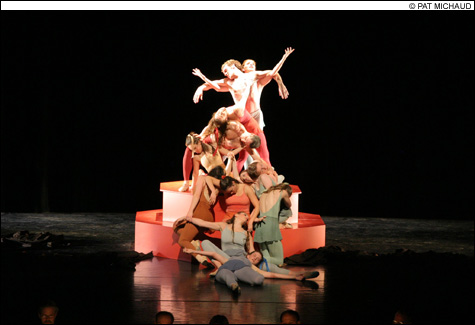
COMPLEMENTARY ARTS Ballet + chorus. PHOTO CREDIT PAT MICHAUD |
The traditional Roman Catholic liturgical text for a requiem mass is a prayer for the dead, evoking horrors of the last judgment. Johannes Brahms however, in composing A German Requiem (1859), turned to the German vernacular translation of the Bible by Martin Luther, for inspiration. The work gestated at the death of his friend, composer Robert Schumann, and was finished more than ten years later, after the death of his mother. It lacks the Dies Irae (“Day of Wrath”) theme of Catholic requiems, and has no specific reference to Christ. Brahms himself said he wished it had been named A Human Requiem. It is a piece that seeks to comfort, not torment, the human condition about death, and aspires to transcend specific religious belief systems.
A seven-movement arch with the brightest movement in the center, its first and last movements convey blessings upon mourners and the dead respectively. The second and sixth movements represent darker emotions. The third and fifth movements feature soloists — a baritone seeking hope, and a soprano bestowing it. The fourth movement gives tranquil choral comfort in “How Lovely Is Thy Dwelling Place.”
This Saturday, the Maine Music Society and Bates College present Brahms’s Requiem at the Basilica of Saints Peter and Paul in Lewiston, in a collaboration that includes the Bates College Choir and Orchestra, Androscoggin Chorale, Maine Chamber Ensemble, and Lewiston and Auburn high school choirs. Hiroya Miura conducts, John Corrie directs the chorus, and soprano Bonnie Scarpelli and baritone Peter Allen are featured soloists. The program also includes two Brahms motets sung by the choirs at the beginning of the concert.
In Portland, on both Saturday and Sunday, another grand choral work is being performed by the Choral Art Society and Portland Ballet Company, directed by Robert Russell and Eugenia O’Brien respectively — a reprise of their 2004 performance of Carl Orff’s Carmina Burana (1936). New choreography by Andrei Bossov will be featured, and Nell Green and Tyler Sperry will perform as principal dancers. Ashley Emerson, Rockland Osgood, and Philip Lima appear as guest soloists.
Historically, the Carmina Burana, also called the Burana Codex, is a collection of more than 1000 poems and songs of the 13th century, now kept in Munich. They are in macaronic dialect — a mixture of Latin, German, and French vernacular. Written by Goliards, clergy who satirized the church, it contains religious, satirical, love, and drinking songs. Ironically, many of the religious songs have been lost. The first page contains a drawing of the Fortuna Wheel, with four phrases surrounding it: “I am reigning, I have finished reigning, I am without reign, I shall reign.”
Orff’s Carmina Burana contains five sections with several movements each. The first movement, “O Fortuna,” of the first section, “Fortuna, Empress of the World,” has been popularized, even clichéd, through its appearance in movies including Excalibur, The Doors, and Natural Born Killers. The remaining sections are “Spring,” “In the Tavern,” “Court of Love,” and “Blanziflor and Helena.” Within each section compositionally, the music addresses the idea of the fortune wheel turning, from hope to grief, joy to bitterness, etc. Orff takes on the fickleness of wealth, drinking, gambling, gluttony, and lust, with sexual themes throughout in Stravinskian style.